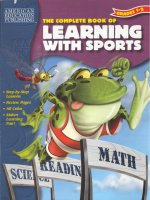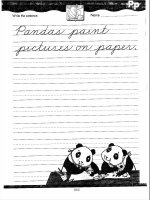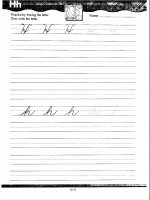The complete book of perfect phrases for high performing sales professionals
Bạn đang xem bản rút gọn của tài liệu. Xem và tải ngay bản đầy đủ của tài liệu tại đây (1.58 MB, 730 trang )
The Complete Book of Perfect
Phrases for High-Performing
Sales Professionals
This page intentionally left blank
The Complete Book of Perfect
Phrases for High-Performing
Sales Professionals
William T. Brooks
Robert Bacal
New York Chicago San Francisco Lisbon
London Madrid Mexico City Milan New Delhi
San Juan Seoul Singapore Sydney Toronto
Copyright © 2010 by The McGraw-Hill Companies. All rights reserved. Except as permitted under the United
States Copyright Act of 1976, no part of this publication may be reproduced or distributed in any form or by
any means, or stored in a database or retrieval system, without the prior written permission of the publisher.
ISBN: 978-0-07-171358-0
MHID: 0-07-171358-1
The material in this eBook also appears in the print version of this title: ISBN: 978-0-07-163609-4, MHID:
0-07-163609-9.
All trademarks are trademarks of their respective owners. Rather than put a trademark symbol after every
occurrence of a trademarked name, we use names in an editorial fashion only, and to the
benefit of the trademark owner, with no intention of infringement of the trademark. Where such
designations appear in this book, they have been printed with initial caps.
McGraw-Hill eBooks are available at special quantity discounts to use as premiums and sales
promotions, or for use in corporate training programs. To contact a representative please e-mail us at
This publication is designed to provide accurate and authoritative information in regard to the subject matter
covered. It is sold with the understanding that neither the author nor the publisher is engaged in rendering
legal, accounting, futures/securities trading, or other professional services. If legal advice or other expert
assistance is required, the services of a competent professional person should be sought.
—From a Declaration of Principles jointly adopted by a Committee of the American Bar Association and a
Committee of Publishers McGraw-Hill books are available at special quantity discounts to use as premiums
and sales promotions, or for use in corporate training programs. To contact a representative please e-mail us
at
TERMS OF USE
This is a copyrighted work and The McGraw-Hill Companies, Inc. (“McGraw-Hill”) and its licensors reserve
all rights in and to the work. Use of this work is subject to these terms. Except as permitted under the
Copyright Act of 1976 and the right to store and retrieve one copy of the work, you may not decompile, disassemble, reverse engineer, reproduce, modify, create derivative works based upon, transmit, distribute, disseminate, sell, publish or sublicense the work or any part of it without McGraw-Hill’s prior consent. You may
use the work for your own noncommercial and personal use; any other use of the work is strictly prohibited.
Your right to use the work may be terminated if you fail to comply with these terms.
THE WORK IS PROVIDED “AS IS.” McGRAW-HILL AND ITS LICENSORS MAKE NO GUARANTEES OR WARRANTIES AS TO THE ACCURACY, ADEQUACY OR COMPLETENESS OF OR
RESULTS TO BE OBTAINED FROM USING THE WORK, INCLUDING ANY INFORMATION THAT
CAN BE ACCESSED THROUGH THE WORK VIA HYPERLINK OR OTHERWISE, AND EXPRESSLY DISCLAIM ANY WARRANTY, EXPRESS OR IMPLIED, INCLUDING BUT NOT LIMITED TO
IMPLIED WARRANTIES OF MERCHANTABILITY OR FITNESS FOR A PARTICULAR PURPOSE.
McGraw-Hill and its licensors do not warrant or guarantee that the functions contained in the work will meet
your requirements or that its operation will be uninterrupted or error free. Neither McGraw-Hill nor its
licensors shall be liable to you or anyone else for any inaccuracy, error or omission, regardless of cause, in
the work or for any damages resulting therefrom. McGraw-Hill has no responsibility for the content of any
information accessed through the work. Under no circumstances shall McGraw-Hill and/or its licensors be
liable for any indirect, incidental, special, punitive, consequential or similar damages that result from the use
of or inability to use the work, even if any of them has been advised of the possibility of such damages. This
limitation of liability shall apply to any claim or cause whatsoever whether such claim or cause arises in contract, tort or otherwise.
Contents
Section One
Section Two
Section Three
About the Authors
Perfect Phrases for
Lead Generation
1
Perfect Phrases for the
Sales Call
263
Perfect Phrases for
Customer Service
483
717
v
This page intentionally left blank
The Complete Book of Perfect
Phrases for High-Performing
Sales Professionals
This page intentionally left blank
Section One
Perfect Phrases for
Lead Generation
Hundreds of Ready-to-Use Phrases for
Finding New Customers, Keeping
Your Pipeline Full, and Growing Your Sales
William T. Brooks
This page intentionally left blank
This section is dedicated to Will and Jeb.They have taught
me that prospects are always good, no matter how
overwhelming things appear to be. I love you guys.
This page intentionally left blank
Contents
Introduction
11
Acknowledgments
13
Chapter 1. The Realities, Myths, Errors, and
Urban Legends Behind Prospecting
Prospecting: What It Is and What It Isn’t 15
The Urban Legends of Lead Generation 16
Selling’s Number-One Secret 18
A Word of Caution 20
The Three Biggest Myths in Lead Generation 20
The Three Biggest Lead-Generation Mistakes and
How to Avoid Them 22
The Hardest Part of Prospecting 25
Chapter 2. Your Direct Value Statement: What to Say
Your Direct Value Statement 27
Using Direct Value Statements 29
Three Types of Contact 31
15
27
5
The Complete Book of Perfect Phrases for Sales Professionals
Chapter 3. Direct Methods of Prospecting—
Cold, Warm, and Hot Calling: What to Say
Cold Calling 34
Cold Call Phrases and Situations 36
A Receptionist or Gatekeeper Answers the Phone 36
The Gatekeeper Is Positive and Receptive, but Your
Prospective Customer Is Reluctant 37
The Gatekeeper Answers the Phone and Your Prospective
Customer Is Positive and Receptive 40
Your Prospective Customer Answers the Phone
and Is Resistant 42
Your Prospective Customer Answers the Phone
and Is Positive 44
Your Prospective Customer Answers the Phone
and Is Indifferent 45
Leaving an Effective Cold Call Voice-Mail Message 47
Warm and Hot Calling: The Key Differences 49
Ten Powerful Visual Presentation Principles 50
Principle 1: Have Lots of “Air” 50
Principle 2: Set Up Wide Margins 51
Principle 3: When in Doubt, Use Ragged Right 51
Principle 4: Keep the Paragraphs Short 53
Principle 5: Keep the Sentences Short 54
Principle 6: Create a Lot of Visual Variety 55
Principle 7: Don’t Italicize or Underline More Than
About Three Words in a Row 55
Principle 8: Don’t Make Underlines Solid 55
Principle 9: Avoid the Use of All Caps 56
Principle 10: Use “Prime-Time Windows” (PTWs)
to Their Full Potential 56
What Prospective Customers Hear 58
A Sample Pre-Approach Communication Document 60
6
33
Perfect Phrases for Lead Generation
Chapter 4. Pre-Approach Campaigns: What to Say
or Write to 25 Types of Prospective Customers
66
The Process of a Pre-Approach Campaign 66
Type 1. Entrepreneur with a General Business
Background 69
Why These Phrases Work 73
What Do You Want Your Prospective Customer to Do? 76
Type 2. Entrepreneur with a Financial Background 79
Type 3. Accountant (Principal) 86
Type 4. Architect (Principal) 90
Type 5. Attorney (Litigating) 94
Type 6. Attorney (Non-Litigating) 98
Type 7. CEO with an Engineering Background 102
Type 8. CEO with a Financial Background 107
Type 9. CEO with a General Non-Entrepreneurial
Background 112
Type 10. Chief Financial Officer 117
Type 11. Corporate Executive 121
Type 12. Dentist/Orthodontist 125
Type 13. Entrepreneur with an Engineering Background 129
Type 14. Entrepreneur with an Operations Background 133
Type 15. Facilities Manager 138
Type 16. Franchisee 142
Type 17. Hospital Administrator 146
Type 18. Human Resources/Training Executive 150
Type 19. Medical/Dental Office Manager 154
Type 20. Oncologist 158
Type 21. Pathologist 162
Type 22. Primary Care Physician 166
Type 23. Purchasing Agent/Manager 170
Type 24. Radiologist 174
Type 25. Surgeon 178
7
The Complete Book of Perfect Phrases for Sales Professionals
Chapter 5. Contacting Warm and Hot Prospective
Customers: What to Say
Warm Call Phrases and Situations 182
The Gatekeeper Is Resistant 183
The Gatekeeper Is Positive, Prospective Customer
Is Resistant 185
The Gatekeeper Is Officious 188
The Gatekeeper Is Receptive, Prospective
Customer Is Positive 189
Your Prospective Customer Answers the Phone
and Is Negative 191
Your Prospective Customer Answers the Phone
and Is Positive 193
Your Prospective Customer Answers the Phone
and Is Neutral 195
You Get Voice Mail 196
Hot Call Phrases and Situations:
The Gatekeeper Answers the Phone 198
Your Prospective Customer Answers the Phone 200
Chapter 6. Always Confirm Every Appointment:
What to Say or Write
Confirming Appointments 201
How to Confirm an Appointment by E-Mail 203
How to Confirm an Appointment by Phone 204
Chapter 7. Multiple Strategies for Lead Generation
and How to Make Them Work
Seminars and Workshops 205
Introducing Your Seminar/Workshop 207
Pre-Presentation Operations 208
Delivery of Seminar Content 209
Question-and-Answer Session 210
8
182
201
205
Perfect Phrases for Lead Generation
Closing Segment 211
Then What? 212
The Result 213
Users Conferences 214
Tips for Making Your Conference a Success 215
How to Organize and Promote Your Event 216
Introducing Your Conference 218
Speeches 219
How to Find Opportunities to Speak 220
What to Title Your Speech 221
How to Arrange to Do a Presentation 223
Networking—It’s Still Alive! 226
Social Event 227
Referral Selling 231
Trade Show Lead Generation 236
Determine Your Objectives 236
What to Do 236
At the Booth: What to Say 238
Working with Redemption Offers 243
One More Point About Leaving Messages 244
Nurture Prospecting 246
The Process of Nurture Prospecting 246
Nurture Prospecting: How It Works 248
Reports 250
The System 252
Confirming Appointments Based on Nurture Prospecting 256
Thank-You and Follow-up Notes: What to Write 257
Another Type of Thank-You Note: What to Write 259
Conclusion 261
9
This page intentionally left blank
Introduction
T
here is no phase of the sale that is more important than
prospecting. Because of that, I have wanted to write this
section for many, many years.
As I soon discovered, it was a difficult narrative to write for
many reasons. For example, simply outlining specific phrases or
terms without linking them to a specific strategy proved to be an
incomplete formula. To compound that, words that don’t match
the emotional buying agenda of a specific type of buyer will only
fall on deaf ears.
As a consequence, I have identified a tightly targeted set of
true 21st-century strategies, linked appropriate phrases to each
strategy, and then tied many to a specific set of words and
phrases that are geared toward the emotional buying agenda of
25 specific types of customers.Think of these 25 as prototypes of
other customer groups not included here and use the strategies,
words,and phrases to develop your approach for generating and
developing your sales leads.
The section is practical, usable, and can be applied to any
sales effort regardless of the product or service you sell.
Therefore, I urge you to feel confident in using the phrases found
11
The Complete Book of Perfect Phrases for Sales Professionals
in the section.They have been tested, proven, and are extremely
effective … and can be used day in and day out in your prospecting effort with great results.
There is not a more practical, user friendly source for
prospecting anywhere. Use that to your advantage. My very best
to you and thank you for obtaining the book. It could be the best
investment you have ever made.
12
Acknowledgments
My deepest appreciation to the late Tom Travisano whose original
research led to many of the best ideas in this section. He was one
of a kind. I’d also like to thank Bonnie Joyce for revising the manuscript more times than could ever be justified. Her patience is
unparalleled. Her skill astounding.Thanks, Bonnie.
13
This page intentionally left blank
Chapter 1
The Realities, Myths, Errors,
and Urban Legends Behind
Prospecting
Prospecting: What It Is and What It Isn’t
W
hether it’s labeled simply as “prospecting” or is
called “lead generation,” “tactical marketing,” “new
customer acquisition,” “cold calling,” “trade show
selling,” “referral marketing,” or “business development,” gaining successful access to qualified leads is the single, most critical component of your long-term sales success—and that is
true no matter what you sell or to whom you sell it.
Why is that? It’s really simple. Most salespeople who fail
eventually tend to do so due to an inadequate supply of qualified leads—period. Without a sufficient number of prospective
customers to call on, anyone’s sales efforts will eventually fail—
even yours. However, even if you do generate a large number of
prospective customers, you will ultimately fail if they are not
qualified. And, ultimately, if you don’t know what to say in order
to get them, you’re really out of luck!
15
The Complete Book of Perfect Phrases for Sales Professionals
Those qualified prospective customers will all have five common traits. The fewer they have of those traits, the less qualified
they are. You want people or organizations with the following
qualifications:
1. They have an awareness of their need for whatever it is
you sell.
2. They have both the authority and the ability to pay for it.
3. They have a legitimate sense of urgency relative to acquiring it.
4. They trust you and your organization.
5. They are willing to listen to you.
This section will supply you with the exact phrases and
words that you should use to guarantee the most positive
response to your prospecting efforts. However, at this point it is
important for us to deal with the most basic question of all about
prospecting. What good would it do for you to present even the
most perfect message to a prospective customer who doesn’t
know that he or she needs your product, doesn’t have sufficient
funds to pay for it, has no authority to access those funds, has no
heartfelt immediacy to purchase it, or doesn’t trust you? Yes, you
guessed correctly—none. No good at all.
So, here’s the biggest trap to avoid: don’t be satisfied with
using any of these phrases with a prospective customer who
merely agrees to listen to you. That is pure folly. It’s fool’s gold
that will only take you closer and closer to sales failure.
The Urban Legends of Lead Generation
The 21st century and its vast array of digital opportunities has
opened a myriad of truly exciting avenues for lead generation.
16









